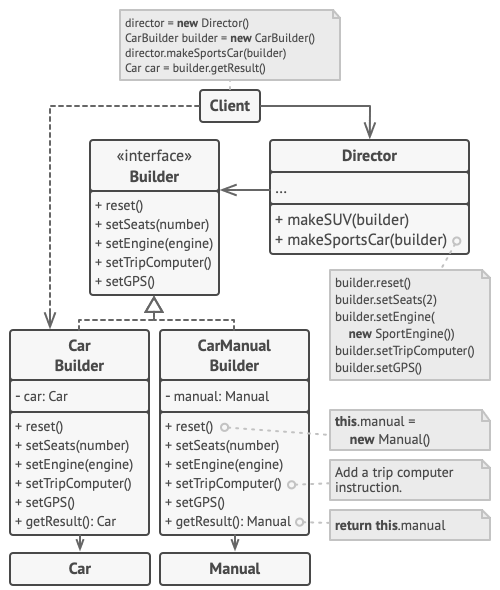Builder
Builder pattern aims to “Separate the construction of a complex object from its representation so that the same construction process can create multiple different representations.”
Lombok’s @Builder annotation is a useful technique to implement the builder pattern.
Example code
User.java
public class User
{
//All final attributes
private final String firstName; // required
private final String lastName; // required
private final int age; // optional
private final String phone; // optional
private final String address; // optional
private User(UserBuilder builder) {
this.firstName = builder.firstName;
this.lastName = builder.lastName;
this.age = builder.age;
this.phone = builder.phone;
this.address = builder.address;
}
//All getter, and NO setter to provde immutability
public String getFirstName() {
return firstName;
}
public String getLastName() {
return lastName;
}
public int getAge() {
return age;
}
public String getPhone() {
return phone;
}
public String getAddress() {
return address;
}
@Override
public String toString() {
return "User: "+this.firstName+", "+this.lastName+", "+this.age+", "+this.phone+", "+this.address;
}
public static class UserBuilder
{
private final String firstName;
private final String lastName;
private int age;
private String phone;
private String address;
public UserBuilder(String firstName, String lastName) {
this.firstName = firstName;
this.lastName = lastName;
}
public UserBuilder age(int age) {
this.age = age;
return this;
}
public UserBuilder phone(String phone) {
this.phone = phone;
return this;
}
public UserBuilder address(String address) {
this.address = address;
return this;
}
//Return the finally consrcuted User object
public User build() {
User user = new User(this);
validateUserObject(user);
return user;
}
private void validateUserObject(User user) {
//Do some basic validations to check
//if user object does not break any assumption of system
}
}
}
UserBuilder.java
public static void main(String[] args)
{
User user1 = new User.UserBuilder("Lokesh", "Gupta")
.age(30)
.phone("1234567")
.address("Fake address 1234")
.build();
System.out.println(user1);
User user2 = new User.UserBuilder("Jack", "Reacher")
.age(40)
.phone("5655")
//no address
.build();
System.out.println(user2);
User user3 = new User.UserBuilder("Super", "Man")
//No age
//No phone
//no address
.build();
System.out.println(user3);
}
Existing Implementations in JDK
All implementations of java.lang.Appendable are infact good examples of the use of the Builder pattern in Java. e.g.
- java.lang.StringBuilder#append() [Unsynchronized class]
java.lang.StringBuffer#append() [Synchronized class]- java.nio.ByteBuffer#put() (also on CharBuffer, ShortBuffer, IntBuffer, LongBuffer, FloatBuffer and DoubleBuffer)
- Another use can be found in javax.swing.GroupLayout.Group#addComponent().
StringBuilder builder = new StringBuilder("Temp"); String data = builder.append(1) .append(true) .append("friend") .toString();

